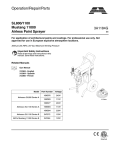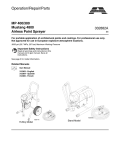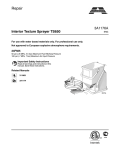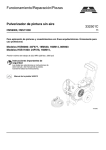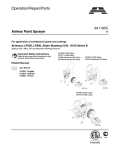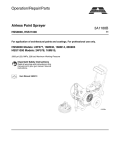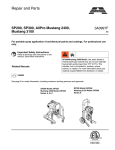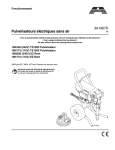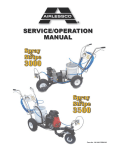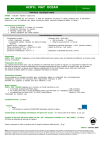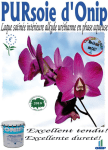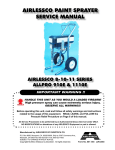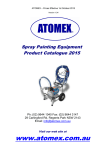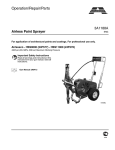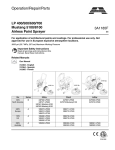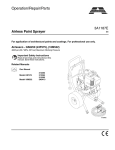Download AIRLESSCO 1110E Instruction manual
Transcript
Operation/Repair/Parts 3A1184A Airless Paint Sprayer ENG For application of architectural paints and coatings. For professional use only. Airlessco - SL1100 (24F572) AllPro - Mustang 11000 (24F584) 3000 psi (20.7MPa, 207 bar) Maximum Working Pressure Important Safety Instructions Read all warnings and instructions in this manual. Save these instructions. Related Manuals Gun Manual 312363 - English 312364 - Spanish 312365 - French ti16141a Warnings Warnings The following warnings are for the setup, use, grounding, maintenance, and repair of this equipment. The exclamation point symbol alerts you to a general warning and the hazard symbols refer to procedure-specific risks. When these symbols appear in the body of this manual, refer back to these Warnings. Product-specific hazard symbols and warnings not covered in this section may appear throughout the body of this manual where applicable. WARNING WARNING GROUNDING This product must be grounded. In the event of an electrical short circuit, grounding reduces the risk of electric shock by providing an escape wire for the electric current. This product is equipped with a cord having a grounding wire with an appropriate grounding plug. The plug must be plugged into an outlet that is properly installed and grounded in accordance with all local codes and ordinances. • Improper installation of the grounding plug is able to result in a risk of electric shock. • When repair or replacement of the cord or plug is required, do not connect the grounding wire to either flat blade terminal. • The wire with insulation having an outer surface that is green with or without yellow stripes is the grounding wire. • Check with a qualified electrician or serviceman when the grounding instructions are not completely understood, or when in doubt as to whether the product is properly grounded. • Do not modify the plug provided; if it does not fit the outlet, have the proper outlet installed by a qualified electrician. • This product is for use on a nominal 120V circuit and has a grounding plug similar to the plug illustrated in the figure below. • Only connect the product to an outlet having the same configuration as the plug. • Do not use an adapter with this product. Extension Cords: • Use only a 3-wire extension cord that has a 3-blade grounding plug and a 3-slot receptacle that accepts the plug on the product. • Make sure your extension cord is not damaged. If an extension cord is necessary, use 12 AWG (2.5 mm2) minimum to carry the current that the product draws. • An undersized cord results in a drop in line voltage and loss of power and overheating. 2 3A1184A Warnings WARNING WARNING FIRE AND EXPLOSION HAZARD Flammable fumes, such as solvent and paint fumes, in work area can ignite or explode. To help prevent fire and explosion: • Do not spray flammable or combustible materials near an open flame or sources of ignition such as cigarettes, motors, and electrical equipment. • Paint or solvent flowing through the equipment is able to result in static electricity. Static electricity creates a risk of fire or explosion in the presence of paint or solvent fumes. All parts of the spray system, including the pump, hose assembly, spray gun, and objects in and around the spray area shall be properly grounded to protect against static discharge and sparks. Use Airlessco conductive or grounded high-pressure airless paint sprayer hoses. • Verify that all containers and collection systems are grounded to prevent static discharge. • Connect to a grounded outlet and use grounded extensions cords. Do not use a 3-to-2 adapter. • Do not use a paint or a solvent containing halogenated hydrocarbons. • Keep spray area well-ventilated. Keep a good supply of fresh air moving through the area. Keep pump assembly in a well ventilated area. Do not spray pump assembly. • Do not smoke in the spray area. • Do not operate light switches, engines, or similar spark producing products in the spray area. • Keep area clean and free of paint or solvent containers, rags, and other flammable materials. • Know the contents of the paints and solvents being sprayed. Read all Material Safety Data Sheets (MSDS) and container labels provided with the paints and solvents. Follow the paint and solvents manufacturer’s safety instructions. • Fire extinguisher equipment shall be present and working. • Sprayer generates sparks. When flammable liquid is used in or near the sprayer or for flushing or cleaning, keep sprayer at least 20 feet (6 m) away from explosive vapors. ELECTRIC SHOCK HAZARD This equipment must be grounded. Improper grounding, setup, or usage of the system can cause electric shock. • Turn off and disconnect power at main switch before disconnecting any cables and before servicing equipment. • Connect only to grounded power source. • All electrical wiring must be done by a qualified electrician and comply with all local codes and regulations. 3A1184A 3 Warnings WARNING WARNING SKIN INJECTION HAZARD High-pressure spray is able to inject toxins into the body and cause serious bodily injury. In the event that injection occurs, get immediate surgical treatment. • Do not aim the gun at, or spray any person or animal. • Keep hands and other body parts away from the discharge. For example, do not try to stop leaks with any part of the body. • Always use the nozzle tip guard. Do not spray without nozzle tip guard in place. • Use Airlessco nozzle tips. • Use caution when cleaning and changing nozzle tips. In the case where the nozzle tip clogs while spraying, follow the Pressure Relief Procedure for turning off the unit and relieving the pressure before removing the nozzle tip to clean. • Do not leave the unit energized or under pressure while unattended. When the unit is not in use, turn off the unit and follow the Pressure Relief Procedure for turning off the unit. • Check hoses and parts for signs of damage. Replace any damaged hoses or parts. • This system is capable of producing 3000 psi. Use Airlessco replacement parts or accessories that are rated a minimum of 3000 psi. • Always engage the trigger lock when not spraying. Verify the trigger lock is functioning properly. • Verify that all connections are secure before operating the unit. • Know how to stop the unit and bleed pressure quickly. Be thoroughly familiar with the controls. EQUIPMENT MISUSE HAZARD Misuse can cause death or serious injury. • Always wear appropriate gloves, eye protection, and a respirator or mask when painting. • Do not operate or spray near children. Keep children away from equipment at all times. • Do not overreach or stand on an unstable support. Keep effective footing and balance at all times. • Stay alert and watch what you are doing. • Do not leave the unit energized or under pressure while unattended. When the unit is not in use, turn off the unit and follow the Pressure Relief Procedure for turning off the unit. • Do not operate the unit when fatigued or under the influence of drugs or alcohol. • Do not kink or over-bend the hose. • Do not expose the hose to temperatures or to pressures in excess of those specified by Airlessco. • Do not use the hose as a strength member to pull or lift the equipment. PRESSURIZED ALUMINUM PARTS HAZARD Use of fluids that are incompatible with aluminum in pressurized equipment can cause serious chemical reaction and equipment rupture. Failure to follow this warning can result in death, serious injury, or property damage. • Do not use 1,1,1-trichloroethane, methylene chloride, other halogenated hydrocarbon solvents or fluids containing such solvents. • Many other fluids may contain chemicals that can react with aluminum. Contact your material supplier for compatibility. 4 3A1184A Warnings WARNING WARNING MOVING PARTS HAZARD Moving parts can pinch, cut or amputate fingers and other body parts. • Keep clear of moving parts. • Do not operate equipment with protective guards or covers removed. • Pressurized equipment can start without warning. Before checking, moving, or servicing equipment, follow the Pressure Relief Procedure and disconnect all power sources. TOXIC FLUID OR FUMES HAZARD Toxic fluids or fumes can cause serious injury or death if splashed in the eyes or on skin, inhaled, or swallowed. • Read MSDSs to know the specific hazards of the fluids you are using. • Store hazardous fluid in approved containers, and dispose of it according to applicable guidelines. PERSONAL PROTECTIVE EQUIPMENT You must wear appropriate protective equipment when operating, servicing, or when in the operating area of the equipment to help protect you from serious injury, including eye injury, hearing loss, inhalation of toxic fumes, and burns. This equipment includes but is not limited to: • Protective eyewear, and hearing protection. • Respirators, protective clothing, and gloves as recommended by the fluid and solvent manufacturer. 3A1184A 5 Component Identification Component Identification C B A D ti16142a F E ti14791a ti14790a A Power switch Turns sprayer ON and OFF B Fuse 20 AMP C Pressure Control Knob Adjusts pressure. Turn clockwise to increase pressure and counterclockwise to decrease pressure. D Prime/Pressure (PR) Relief Valve Primes pump and relieves pressure from gun, hose and tip. E Prime/Pressure (PR) Relief Valve Open Position Relieves pressure from gun, hose and tip and primes the unit when in the open position. Valve is in open position when there is a wider gap between valve handle and cam body. Refer to Pressure Relief Procedure page 7 F 6 Prime/Pressure (PR) Relief Valve Closed Position Pressurizes system when closed. Valve is in closed position when there is a slight gap between valve handle and cam body. 3A1184A Operation Operation Pressure Relief Procedure 5. Re-engage gun trigger lock and close Prime/Pressure Relief Valve. To reduce risk of injury, follow this pressure relief procedure whenever you see this symbol throughout this manual, Also, perform this procedure whenever you: • Stop spraying ti14790a • Check or repair any part of this system • Install or clean spray nozzle 1. Engage the gun trigger lock. Refer to the separate instruction manual provided with gun for safety features and how to engage the trigger lock. 2. Turn the unit off. 3. Disengage the gun trigger lock and trigger the gun to relieve residual fluid pressure. Hold metal part of the gun in contact with grounded metal pail. Use minimum pressure. ti15989a 4. Turn Prime/Pressure Relief Valve (PR Valve) to the open (priming) position to relieve residual pressure. If the spray tip or hose is clogged, follow Steps 1 through 5 above. Expect paint to splash into the bucket while relieving pressure during Step 4. NOTE: If you suspect that pressure hasn’t been relieved due to damaged Prime/Pressure Relief Valve, or other reason, slowly loosen the tip nut or hose coupling to relieve pressure. Setup • To reduce the risk of static sparking, fire or explosion which can result in serious bodily injury and property damage, always ground the sprayer and system components and the object being sprayed, as instructed in the safety warning section of this manual. • Ensure electrical service is 120 VAC, 15 amp minimum and the outlet is properly grounded. • For generator power, a minimum 7000 watt generator with a voltage regulation must be used. Connect the hose and gun ti14791a There will be a wider gap between valve handle and cam body when in open position. In the closed position there is only a very slight gap. NOTE: The valve handle can move both clockwise and counter clockwise and can face different directions. 3A1184A 1. Remove the plastic cap plug from the outlet and screw a conductive or grounded 3000 psi spray hose onto fluid outlet. 2. Connect an airless spray gun to the other end of the hose. Do not install spray tip. NOTE: Do not use thread sealer on swivel unions as they are made to self seal. 7 Operation Flushing Fill the Packing Nut/Wet Cup 1. Fill the Packing Nut/Wet Cup with 5 drops of Airlessco Throat Seal Oil (TSO). • To reduce the risk of static sparking, which can cause fire or explosion, always hold a metal part of the gun firmly against the metal pail when flushing. This also reduces splashing. • Always remove the spray tip before flushing. ti16049a Flush the Sprayer 1. Flush the sprayer. See Flushing Procedure on page 8. 1. Make sure the gun trigger lock in engaged and there is no spray tip in the gun. Refer to the separate instruction manual provided with gun for safety features and how to engage the trigger lock. Prime and Flush Storage Fluid NOTICE The equipment was tested with lightweight oil, which is left in the fluid passages to protect parts. To avoid contaminating your fluid with oil, flush the equipment with a compatible solvent before using the equipment for the first time. Before beginning a new spraying project you need to prime the sprayer and flush the storage fluid out of the sprayer. Oil- or Water-based Materials • When changing from water-based material to oil based material, flush with soapy water and then mineral spirits. • When changing from oil based material to water base material, flush with mineral spirits, followed by soapy water, then a clean water flush. • When flushing with solvents, ground pail and gun. • Flush before changing colors, before fluid can dry in the equipment, at the end of the day, before storing, and before repairing equipment. ti16028a 2. Pour enough clean, compatible solvent into a large, empty metal pail to fill the pump and hoses. 3. Place the suction tube into the pail or place the pail under the pump. 4. Turn Pressure Control Knob to low. High Pressure ti16048a 5. Open the prime valve to the open - “Priming Position”. This will allow an easy start. Closed (Pressure) Open (Priming and Pressure Relief) ti14790a ti14791a 6. Turn the engine ON/OFF switch to ON. 8 3A1184A Operation 7. Point the gun into the metal pail and hold a metal part of the gun firmly against the pail. Maintain firm metal to metal contact between gun and container. b. After ensuring the gun trigger lock is engaged, attach tip and safety guard. c. Turn the engine ON/OFF switch to the “ON” position. d. Turn the Pressure Control Knob clockwise to prime the pump. e. After the pump is primed, turn the Prime/PR Valve to the “CLOSED” position. f. Turn Pressure Control Knob to the desired spray pressure. g. Disengage the gun trigger lock to begin spraying. ti15989a 8. Disengage the gun trigger lock and squeeze the trigger. At the same time, slowly turn the pressure control knob clockwise, just enough to move liquid at low pressure. 9. Allow the pump to operate until clean solvent comes from the gun. Adjusting the Pressure 10. Release the trigger and engage the gun trigger lock. 11. If you are going to start spraying, place the pump or suction tube into the supply container. Release the gun trigger lock and trigger the gun into another empty, metal container, holding a metal part of the gun firmly against the metal pail, forcing the solvent from the pump and hose. When paint starts coming from gun, turn pressure control knob to minimum pressure, place prime valve in prime (open) position and engage the gun trigger lock. 12. If you are going to store the sprayer, remove the suction tube or pump from the solvent pail, force the solvent from the pump and hose. Engage the gun trigger lock. See Storage, 10. 13. Whenever shutting down the sprayer, follow Pressure Relief Procedure, page 7. NOTICE To prevent damage and freezing during storage, never leave water in the fluid pump Startup 1. Prepare the material according to the material manufacturer’s recommendations. • To reduce the risk of injection, never hold your hand, body, fingers or hand in a rag in front of the spray tip when cleaning or checking for a cleared tip. Always point the gun toward the ground or into a waste container when checking to see if the tip is cleared or when using a self cleaning tip. • When you spray into the paint bucket, always use the lowest spray pressure and maintain firm metal to metal contact between the gun and container. • To stop the unit in an emergency, turn the engine off. Then relieve the fluid pressure in the pump and hose. See Pressure Relief Procedure, page 7 When adjusting the pressure, turn the Pressure Control Knob clockwise to increase pressure and counterclockwise to decrease pressure. Always use the lowest pressure necessary to completely atomize the material. If more coverage is needed, use a larger tip rather than increasing the pressure. NOTE: Operating the sprayer at higher pressure than needed wastes material, causes early tip wear, and shortens sprayer life. NOTE: Check the spray pattern. The tip size and angle determines the pattern width and flow rate. 2. Place the suction tube into the material container. 3. Start the sprayer. a. 3A1184A Prime/PR Valve must be “OPEN” in the priming position. 9 Operation Shutdown 1. Relieve Pressure, page 7. 2. Clean the tip and gun as recommended in the separate Gun Manual supplied with the gun. 3. If spraying water-based material or a material that could harden in the sprayer overnight, flush the sprayer after use. See Flushing, page 8. Storage Short Term 1. Flush sprayer with compatible solvent before storing, then fill the pump and hoses with an oil based solvent such as mineral spirits or Graco or Airlessco Pump Armor. • • For oil base paint: flush with mineral spirits For water-base paint: flush with water, then mineral spirits and leave the pump, hose and gun filled with mineral spirits. Long Term For longer storage, use Graco or Airlessco Pump Armor. Shut off sprayer, Relieve Pressure, page 7, and make sure prime valve is left open. Start Up After Storage Before using water-base paint, flush sprayer with soapy water and then a clean water flush. When using oil-base paint, flush out the mineral spirits with the material to be sprayed. NOTE: Always store unit indoors. 10 3A1184A Maintenance Maintenance Electric Motor Maintenance Regular Maintenance 1. Always stop the pump at the bottom of its stroke when you take a break or at the end of the day. This helps keep material from drying on the rod, damaging the packings. 2. Keep displacement pump packing nut/wet cup 1/3 full of Airlessco Throat Seal Oil at all times. The TSO helps protect the packings and rod. 3. Lubricate Connecting Rod Pin every 3 months. Daily Maintenance Inspect the packing nut daily. If seepage of paint into the packing nut and/or movement of the piston upward is found (while not spraying), the packing nut should be tightened just enough to stop leakage. Overtightening will damage the packings and reduce the packing life. Lubrication The motor is supplied with pre-lubricated ball bearings, lubricated for the life of the bearing. Motor Brushes Motor brushes need periodic inspection and replacement as wear indicates. Standard Leeson brushes have an initial length of 1 and 1/4” and should be replaced when they are worn to a length of 5/8”. Brush wear is greatly influenced by individual application and it is recommended that brush wear be checked at early intervals of operation in order to determine future required inspection. To change the brushes: 1. Unplug the machine. Oil and Lubrication Instructions 2. Remove the cover over the motor. 3. Open the two covers at the rear of the motor. Bleed (Weep Hole) 4. Loosen the screw under the brush. 5. Pull out the wire. Sealed Bearing 1 oz. SAE 30W Oi - semi-annually 6. Push the brush retainer clip in and withdraw. 7. Remove the worn brushes. 8. Install new brushes in the reverse order. Oil impregnated sleeve - dip in hot 10W oil when removed Fill plug- unit has grease in gearbox from factory and will not require changing. (Grease - PN 301178) ti15992a 3A1184A To increase brush life, new brushes (Part #3301146 for 110 volt) need to have a run in period. After changing brushes, set the machine for spraying. With a bucket of Pump Conditioner and water, a 50’ 1/4” airless hose, airless gun and tip on unit, open the prime valve and switch on. The pump will now prime. With pump running in the prime mode, turn the pressure control knob to high pressure. (The pump has to cycle fast with no pressure in the pump). Run the pump for 20 minutes and the brushes will be run in. 11 Maintenance Replacement of Belt/Belt Adjustment Servicing the Fluid Pump NOTE: The Cog Belt System does not require alignment. When upper sheave is placed on motor shaft it is pushed on until a positive stop is reached. The set screws are then loctited. The lower pulley is placed on gearbox and held in place with keyway and snap ring. The flange on upper sheave holds the belt in alignment and the belt self aligns on lower pulley eliminating having to align. NOTE: Before disassembling the sprayer refer to Troubleshooting to try and resolve the problem. Fluid Pump Disconnect 1. Flush out the material you are spraying, if possible. 2. Relieve Pressure, page 7. Stop the pump in the middle of down stroke. 3. Remove the suction tube and fluid hose (if so equipped) from the fluid pump. 1. Remove cover from unit. 2. Remove tensioner Assembly. Loosen screws. Move gearbox forward to allow removal and replacement of belt. 4. Remove the connecting rod shield from the pump. 3. Retighten screws into gearbox until they bottom out. This will align gearbox correctly. 5. Remove two retaining rings (6), slip the sleeve of the coupling down, and remove both coupling halves. This will disconnect fluid pump from the connecting rod. 4. Replace tensioner with bolts and leave loose to allow adjusting belt tension. 6. Using a 7/8” box wrench, disconnect the high pressure fluid line from the pump. 5. Tighten belt. When properly tightened the deflection play should be 1/4 inch when pushing hard with thumb. (20 ft/lbs) 7. Using a 9/16” wrench, unscrew the two tie rod locknuts. 8. Pull the pump off the tie rods. NOTE: When placing belt on pulleys and inserting the tensioner against belt, ensure cogs on belt are engaged into cogs on pulleys before tightening belts. Rotating upper pulley while holding the tensioner against the belt will allow proper engagement of cogs prior to tightening. 1 2 3 4 5 6 6 16 7 8 15 9 14 13 ti16032a 12 10 11 ti16033a 12 3A1184A Maintenance Fluid Pump Reinstall 1. Loosen the packing nut and extend piston rod to fully up position. Slip sleeve over the piston rod. 4. Remove the retaining ring from the packing nut and insert into coupling halves. ti15998a 5. Secure the fluid pump housing to the tie rods and screw locknuts with washers on loosely. ti16033a 2. Insert one of the retaining rings through the packing nut and rest the sleeve on top of it. 6. Tighten the tie rod locknuts evenly to 30 ft. lb. NOTE: After all the rod locknuts are tight, the alignment of both rods should allow easy assembly and disassembly of the coupling. If any binding, loosen and retighten all the rod locknuts to improve the alignment. Misalignment causes premature wear of seal and packings. ti15995a ti15996a 3. Connect the connecting rod with the fluid pump by installing the coupling halves. Slide sleeve over the coupling halves and secure with retaining rings. 7. Tighten packing nut clockwise until resistance against the packings can be felt. Turn it one full turn more. 8. Start the pump and operate it slowly (at low engine speed) to check the piston rod for binding. Adjust tie rod lock nuts if necessary to eliminate binding. 9. Prime the unit and run at maximum pressure for several minutes, then release the pressure and repeat step 7. 10. Fill the wet cup (packing nut) with five drops of TSO (Throat Seal Oil). ti15997a 3A1184A 13 Maintenance Servicing Inlet Nut and Outlet Valve Inlet Valve 6 1. Using the rod collar tool (865008), unscrew the suction nut (6), containing suction seat support (5), off of the fluid body. 2. Remove suction seat (3), O-ring (2), suction ball (1) and suction ball guide (8) with O-ring (2). 3. Clean all parts and inspect them for wear or damage, replacing parts as needed. Old O-rings (2) should be replaced with new ones. NOTE: Suction seat (867574) is reversible. Piston Outlet Valve 1. Place piston holder in a vise. Slide piston into the holder and lock in place with a 1/4” dowel. 2. Use a 3/8” allen wrench to unscrew the outlet seat support (12) from the piston. 3. Remove the outlet seat (11), O-ring (2), outlet ball (9), and ball guide (8). 4. Inspect outlet ball (9) and seat for wear. Replace as required. 1 4 5 6 2 3 NOTE: Outlet seat (867575) is reversible. ti16143a 5. While piston is still locked in the holder, install parts back into the piston in the following order: • • • • Ball guide (8) Ball (1) O-ring (2) Outlet Seat (11) Before reinstalling the outlet seat support (12) apply two drops of Loctite No. 242 (blue) on the threads and torque to 20 ft-lbs. 7 8 9 10 11 ti16144a 12 14 3A1184A Maintenance Packing Replacement Procedures Disassembly of the Fluid Pump 1. Unscrew and remove the packing nut (2). 2. Push the piston rod (1) down through the packings and out of the pump. 3. Now push the packing removal tool up through the pump and remove from the top bringing the packings, spacer (4) and springs along with it, leaving fluid body (3) empty. NOTE: Make sure all old packings and glands have been removed from fluid pump. 6. Take assembled glands and packings (13 pieces) and slide onto the lower half of the piston. 7. Take the spacer (4) and slide over the top of the piston (it doesn’t matter which direction it sits), falling onto the lower packings. 8. Take three Belleville Springs (19) and slide over the top of the piston in the following order: • • • First spring - curve facing down Second spring - curve facing down Third spring - curve facing down 4. Clean inside of fluid body (3). 9. Take the upper male gland (20) and place it rounded side up. 5. Disassemble all parts and clean for reassembly. Discard any old packings. Save the metal upper glands. Replace metal lower glands with new metal glands from the packing kit. 10. Take three upper polyethylene V-packings (22) and two leather packings (21) and assemble with inverted side down, on to the male gland (20) in the following order: NOTE: If the old packing had a metal gland for (866100), discard and replace with a new plastic one from packing kit. 6. Lubricate leather (15, 21) packing in lightweight oil for 10 minutes prior to reassembly. Reassembly of the Fluid Pump 1. Place lower male gland (16) down on the flat side. 2. Take three of the lower polyethylene V-packings (17) and two of the leather V-packings (15) and place onto the male gland (16), with the inverted side down, in the following order: • • • • • Polyethylene (17) Leather (15) Polyethylene (17) Leather (15) Polyethylene (17) 3. Take the female adaptor (18), which is inverted on both sides, and place it on top of your assembled lower packings. 4. Follow step 2 with your packings inverted side up. 5. Take the second lower male gland (16) and place it on top of your assembled packings with rounded side down. 3A1184A • • • • • Polyethylene (22) Leather (21) Polyethylene (22) Leather (21) Polyethylene (22) 11. Take upper female gland (23) and place on top of assembled upper packings with the inverted side down. 12. Take assembled upper glands and packings (7 pieces) and slide on over the top of the piston, making sure inverted sides are down. 13. Take the V-packing holder and replace the white O-ring (25) and the black O-ring (26) with new ones from the packing kit. 14. Slide the V-packing holder (24) over the top of the upper packings so they fit inside. 15. Lubricate inside of the fluid pump body and the outside of the packings with a light weight oil. 16. Slide assembly into fluid pump body. NOTE: To keep packings secured in correct position, hold the pump body upside down and push the completed assembly upwards into the pump body. Once placed inside, tilt pump body back up to keep all pieces in. 15 Maintenance 19. Take the completed suction valve assembly and place it into the bottom of the fluid body (3), with the rounded side fitting inside. 17. Thread the packing nut (2) into the top of the fluid body (3) and tighten hand tight. 18. Take the suction retainer (10) and replace the black O-ring (26) with a new one from the packing kit. Replace the suction ball (11) with a new one from the kit into the suction retainer (10). Place the suction seat (13) into the flat side of the ball guide (6), over the suction ball (11). Now place the white O-ring (25) into the groove around the suction seat (13). 20. Take the suction seat support (12) and place the flat side down on to the suction valve assembly (threads will be facing upwards). 21. Thread the suction nut, over the suction seat support (12). 22. Tighten the packing nut (2) (utilizing the packing nut adjustment tool) clockwise one full turn. 24 23 1 25 26 22 1 2 21 23 22 20 21 3 19 20 19 4 16 17 5 6 7 8 9 15 4 18 17 16 15 17 18 10 16 15 14 13 11 12 ti16002a 17 16 ti16001a 16 3A1184A Maintenance Pressure Control Assembly Calibration NOTE: Anytime a sensor or pressure control assembly (board) or both are replaced, the following calibrations must be performed. NOTE: Pressure control assemblies (boards) are now being equipped with a green grounding wire attached. Connect the grounding wire to terminal box using the same screw that holds the grounding wire from the power cord. Pressure Calibration 1. Complete the ZERO calibration, as per “ZERO CALIBRATION” prior to commencing this calibration. 2. Attach a 50’, 1/4” airless hose, airless gun with 0.017 tip and a 5000 psi glycerin filled pressure gauge to pump. 3. Place the suction tube into a bucket of Pump Conditioner and water. Zero Calibration 1. Place prime/pressure relief valve in the prime (open) position. 2. Set the pressure control knob to the minimum setting (CCW). 3. Remove the screws and lower the pressure control assembly. 4. Remove any jumper on the “P-ZR” terminal. NOTE: This jumper is no longer used. 5. Turn machine “ON” and ensure it is not cycling. 6. If the yellow light on the electrical board is ON and you have “0000” on the LCD display, the Zero Calibration is complete no further adjustment is necessary. If the light is ON and there are numbers on the display, use an insulated screwdriver to turn the “ZERO” trimpot counter-clockwise until the light goes out. Then turn it clockwise until the yellow light comes on, continue to turn the trimpot and the numbers will reduce until the LCD shows “0000”. The Zero Calibration is now complete. If you adjust beyond “0000”. The Zero Calibration is now complete. If you adjust beyond “0000” the numbers will start to increase. If the digital display shows “---” and no yellow light, you should turn the Zero trimpot clockwise until the yellow light is on, continue turning until “0000” is shown. The goal is to see the “0000” on the digital display, this is when you have Zero Calibration (Relying on the yellow light is no longer used.) 3A1184A 4. Turn prime/pressure relief valve to the prime (open) position. 5. Turn pressure control knob clockwise until machine starts to prime. 6. Place the prime/pressure relief valve in the pressure (closed) position. 7. While watching pressure gauge, slowly adjust the pressure trimpot (clockwise to increase and counter clockwise to decrease) until the maximum static pressure is 3000 psi, with the pressure control knob fully clockwise. Trigger the gun several times to ensure pressure returns to 3000 psi. LCD Display Calibration If so equipped 1. Complete the “ZERO CALIBRATION” and “PRESSURE CALIBRATION” procedures prior to commencing this calibration. 2. Turn pressure control knob up until system pressure is above 2500 psi (as indicated on the glycerin filled pressure gauge) and the machine is not cycling. 3. Use an insulated screwdriver to adjust the Set trimpot. Turn trimpot CCW until it clicks, then adjust to match pressure against pressure gauge reading. 4. Move the pressure control knob to different settings and trigger the gun several times to ensure that the LCD continues to match the pressure gauge reading. 17 Maintenance Phase Limit Calibration Sensor Formerly known as the low voltage or master voltage calibration. 1. Remove the screws and lower the pressure control assembly. 1. Attach a 50’, 1/4” airless hose, airless gun with .017 tip and a 5000 psi glycerin filled pressure gauge to the pump. 2. Disconnect sensor lead from the board. 2. Place the suction tube into a bucket of Pump Conditioner. 4. Reassemble in reverse order. Use PTFE tape on the sensor threads prior to reinstalling it into the pressure control assembly. 3. Turn pump on and turn up pressure control until the machine starts to prime. 4. Place the prime/pressure relief valve in the pressure (closed) position. 3. Unscrew sensor from pressure control assembly using a 7/8” wrench. Potentiometer 1. Lower pressure control assembly as described above. 5. Pressurize pump to 600 psi. 6. Trigger the gun several times noting the deadband (the amount of pressure drop before the pump rebuilds to set pressure). 7. If deadband is greater than 150 psi, adjust the phase limit trimpot so that the deadband is less than 150 psi and the pressure increase after the gun trigger is released is less than 250 psi. These pressures are guidelines and may vary slightly from pump to pump. 8. Reattach pressure control assembly to unit. Replacement of Electrical Components 2. Disconnect potentiometer lead from pressure control assembly. 3. Use a 1/16” allen wrench, loosen set screw in the poteniometer knob and remove knob and spacer. 4. Using a 1/2” wrench or deep socket, remove the nut from the potentiometer shaft assembly. 5. Pull entire potentiometer assembly out of the frame. 6. Replace in reverse order. On-Off Toggle Switch 1. Lower the pressure control assembly as described above. 2. Disconnect the two wires on the toggle switch. 3. Use a 9/16” wrench to loosen the nut on the toggle switch shaft. Always unplug the electrical cord before servicing the machine. NOTE: Anytime the pressure control assembly, sensor, or both are replaced, perform the calibrations. Pressure Control Assembly (Electrical Control Board) 1. Unplug machine’s power cord. 2. Remove eight screws and lower the pressure control assembly. 3. Disconnect all leads from pressure control assembly. 4. Reassemble in reverse order. Circuit Breaker 1. Lower pressure control assembly as described above. 2. Disconnect the two wires on the holder. 3. Unscrew rubber boot from breaker shaft. 4. Use a 1/2” wrench to remove the bushing from the breaker shaft. 5. Remove breaker from frame. 4. Reassemble in reverse order. 18 3A1184A Maintenance Liquid Crystal Display (LCD) 1. Ensure the power switch is OFF and the machine is unplugged. 2. Detach the pressure control assembly from the frame by unscrewing the eight screws. 3. Disconnect the LCD lead from the pressure control assembly. 4. Separate the LCD assembly from the frame by undoing the four screws. 5. Remove and replace LCD Display. 6. Reassemble in reverse order. NOTE: Do not over tighten the screw and nuts. This can warp the LCD and damage it. 7. Perform LCD Calibration Procedure, page 17. 3A1184A 19 Troubleshooting Troubleshooting General Problem Unit doesn’t prime Unit primes but has poor or no pressure Unit does not maintain good spraying pressure Cause Airleak due to loose suction nut Tighten suction nut. Airleak due to worn o-rings Replace o-ring (110636) on suction seat and o-ring (867390) below suction seat. Stuck or fouled balls Service inlet and outlet valves. Prime/Pressure Relief valve not opening Clean or replace Prime Valve (866428) Pressure set too low Turn up pressure. Filter(s) are clogged Clean or replace gun filter, inlet filter, and/or manifold filter. Outlet valve fouled/worn. Service outlet valve. Prime/pressure relief valve bypassing Clean or replace prime valve (866428). Packings and/or piston worn Tighten packing nut, repack unit. Blown spray tip Replace spray tip. Packings and/or pistons worn Repack unit. Upper seat worn Replace upper seat. Unit does not run Machine does not start 20 Solution See Machine Does Not Start Control Settings Make sure machine is plugged into the wall. Verify the on-off switch is in the ON position and the pressure control knob is turned all the way to the right (clockwise for maximum pressure). Circuit Breaker Use multi-meter to test the breaker for continuity or replace with a new breaker. If breaker reads good, see Power Source. 3A1184A Troubleshooting Problem Cause Power Source Solution Using a Phillips Head screwdriver, remove the eight screws holding the pressure control assembly. Locate the red light on the board indicating there is power. If the light is ON, see Pressure Control Assembly (Board). If the light is OFF, locate the L1 and L2 terminals on the board. Use the multi-meter to ensure there is 110 volts AC across the two terminals (the cord wires will still be attached.) If there is no voltage at the leads, there is no power getting to the machine. Check the power source (outlet, circuit breaker, extension cord, and power cord). If you have AC voltage at the L1 and L2 terminals, disconnect the two red motor leads (S1 and S2) and test for continuity between them. No continuity means the thermal coupler has opened due to excessive motor heat. If the motor is still hot to the touch, allow it to cool and then retest. If the motor is cool and there is not continuity on the red leads, contact Airlessco Technical Support to repair/replace the thermal coupler. Continuity shows that the motor’s thermal coupler has not tripped. See Pressure Control Assembly (Board). Pressure Control Assembly (Board) If the power indicating light is still out after checking the control settings, fuse and power source, replace the pressure control assembly. Motor Remove the motor brush covers and turn the machine ON. Set the potentiometer (POT) at maximum pressure and check for DC voltage across both brush terminals. It should read greater than 80 volts DC. If you have DC voltage, turn the machine off and unplug it from the wall. Check to make sure the brushes are making good contact with the armature. Replace the brushes if they are less than 5/8” long. If the brushes are good, replace the motor. If you do not have DC voltage, see Sensor. 3A1184A 21 Troubleshooting Problem Cause Sensor Solution Plug another sensor board into the board and perform the zero calibration procedure. If the machine starts to run, the sensor is bad. If there is no replacement sensor available, use a multi-meter to test the resistance across the red and black wires of the sensor (be sure to test the plug). You should read 1.5 - 3.5k ohms. A faulty sensor usually reads no continuity (open). If the sensor passes all the tests, see Pressure Control Knob (Potentiometer). Pressure Control Knob (Potentiometer) Plug another potentiometer (POT) into the control board. If the machine starts, the old POT is bad. When a replacement POT is not available, remove the POT lead (with the machine turned off) from the control board and test the resistance between the red and black wires (be sure to test at the plug). The resistance should read between 8-12k ohms. If it is outside of this range replace the POT. If there is DC voltage at the motor brushes and the sensor and pressure control knob are functioning, replace the pressure control assembly. Airless Spray Gun Problem Cause Solution Coarse spray Low pressure Increase the pressure Excessive fogging (overspray) High pressure Reduce the pressure to satisfactory pattern distribution. Material too thin Use less thinner Pattern too wide Spray angle too large Use smaller spray angle tip Pattern too narrow Spray angle too small Use larger spray angle tip (if coverage is OK, try tip in same tip group) Too much material Tip too large Use smaller tip Material too thin Use smaller tip Pressure too high Reduce pressure Tip too small Use next larger tip Material too thick Too little material 22 3A1184A Troubleshooting Problem Cause Solution Thin distribution in center of pattern “horns” Worn tip Change to new tip Wrong tip Use tip with narrow spray angle Thick skin on work Material too viscous Thin cautiously Application too heavy Reduce pressure and/or use tip in next smaller tip size Coating fails to close and smooth over Material too viscous Thin cautiously Spray pattern irregular, deflected Orifice clogged Clean carefully Tip damaged Replace with new tip Craters or pock marks, bubbles on work Solvent balance Use 1 to 3% “short solvents remainder “long” solvents (this is most likely to happen with material of low viscosity, lacquers, etc.) Clogged screens Extraneous material in paint Clean screen Course pigments Use coarse screen if orifice size allows. Poorly milled pigments (paint pigments glocculate) Use courser screen, larger orifice tips. Obtain ball milled paint. If thinner had been added, test to see if a cover screen. Incompatible drop placed on top of paint mixes or flattens out on the paint mixture and thinners on the surface. If not, try different thinner in fresh batch of paint. Excess paint builds on tip guard Spray gun too close to surface Hold gun further from surface sprayed Pressure setting too high Reduce pressure setting Drips, spits from tip Valve seat and/or ball in gun head damaged or worn Service spray gun, replace valve assembly Tip clogs continually Debris in paint Thoroughly strain the paint before use Gun filter missing Do not operate without inlet strainer Coarse filter mesh Do not operate without inlet strainer 3A1184A 23 Parts Parts Paint System 15 1 2 14 3 13 16 17 12 11 10 4 12 11 18 19 20 9 8 6 5 7 Ref. 1 2 3 4 5 6 7 8 9 10 24 Part 866428 24D688 866282 301308 867311 867400 121112 331103 867417 866052 ti16145a Description Qty. Prime Valve 1 Drain Hose 1 Pressure Control Assembly (110V) 1 Hose 1 Nipple 1 Hose 1 Screw 2 Washer 2 Plug (1/4”) 1 Cap Plug Set Ref. 11 12 13 14 15 16 17 18 19 20 Part 867309 867188 866123 866334 301337 867420 867417 866445 305140 867534 Description Nipple (3/8”-1/4”) Elbow Manifold Filter Sensor Screw Plug (3/8”) Plug (1/4”) Spacer Filter Bracket Screw Qty. 1 1 1 1 8 1 1 2 1 2 3A1184A Parts Manifold Filter (865627) 1 2 3 5 4 6 8 7 9 8 ti16052a 10 Ref. 1 2 3 4 5 3A1184A Part 867145 301356 867377 867214 867647 Description Base Spring O-Ring Filter 60 Mesh Support Qty. 1 1 1 1 1 Ref. 6 7 8 9 10 Part 867077 867004 867420 867309 867417 Description Base Swivel Plug 3/8” Nipple 3/8”M x 1/4”M Plug 1/4” Qty. 1 1 2 1 1 25 Parts Fluid Pump 1 2 3 4 5 6 6 16 7 8 15 9 14 13 12 10 Ref. Part Description 1 2 3 4 5 6 7 8 9 10 11 12 13 14 15 16 866143 301320 867529 301105 301046 867468 866074 866069 301467 866267 866241 140051 140035 301173 301159 867641 Gearbox 1” (1100/1110E) Cover Screw Hook Rod End Retaining Ring Coupling Set Retaining Ring Front Shield SL Paint Pump Assembly Suction Nut Nut Lock Washer Bracket-Return Tube Spacer Stud Qty. 1 1 1 1 1 1 1 1 1 1 1 2 2 1 2 2 11 ti16033a 26 3A1184A Parts Inlet and Outlet Valves 6 Ref. Part Description 1 2 3 4 5 6 867051 556562 867574 866306 866400 866241 Ball O-Ring Suction Seat Retainer Support, Suction Seat Nut Ref. Part Description 7 8 9 10 11 12 187330 866307 867047 104319 867575 187020 Piston Rod Ball Guide Outlet Ball O-Ring Outlet Seat Outlet Seat Support Qty. 1 1 1 1 1 1 1 4 5 6 2 3 ti16143a 7 Qty. 1 1 1 1 1 1 8 9 10 11 12 ti16144a 3A1184A 27 Parts Complete Sprayer 49 27 42 54 53 52 11 10 9 8 7 6 51 50 36, 37, 38, 39, 41 13 14 35 1 33 16 45 3 17 18 19 17 4 21 22 23 46 47 43 44 34 32 48 20 24 25 5 26 31 27 56 57 58 29 28 30 55 ti16146a 28 3A1184A Parts Ref. 1 2 3 4 5 6 7 8 9 10 11 13 14 16 17 18 19 20 21 22 23 24 25 26 27 28 Part 301320 121112 867529 301105 301467 301337 867417 867528 867301 867704 301193 866143 301333 301046 867468 866074 866069 301047 867641 301139 867461 301059 301173 140035 140051 301134 Description Cover Screw Screw Hook Front Shield Screw Plug 1/4 NPT Screw Lock Washer Washer Tensioner Assembly Gearbox 1” (1100/1110E) Connecting Rod Assembly Rod End Retaining Ring Coupling Set Retaining Sleeve Sleeve Bearing Stud Woodruff Key Retaining Ring Spacer Bracket Return Tube Lock Washer Nut Stopper Qty. 1 4 2 1 1 2 1 2 2 2 1 1 1 1 2 1 1 1 2 1 1 2 1 2 2 2 29 866025 Axle 1 30 143029 Set Collar 2 31 32 33 301165 Wheel 301316 Rubber Edge 1.17’ (makes 2) 301337 Screw 2 1 4 34 140029 Washer 1 Ref. 35 36 37 38 39 41 42 43 44 45 46 47 48 49 50 51 52 53 54 55 56 57 58 Part Description Qty. 342425▲ High Voltage Label 1 301190 Fan 1 301191 Retaining Clip Fan 1 867554 Screw 3 866228 1.25HP Motor 1 301089 Fan Cover 1 301321 Cover 1 867324 Nut 4 867301 Lock Washer 4 301337 Screw 4 301135 Grommet 6 301231 Cog Belt 1 866455 Cog Pully 1 301206 Frame 1 101118 Set Screw 2 866452 Sheave 1 866212 Key 1 301099 Retainer 3 301044 Screw 3 141010 Inlet Strainer 1 866241 Suction Nut 1 866400 Suction Fitting 1 301004 Suction Tube 1 HSE1450 Hose, 1/4” x 50 (not shown) 1 289316 Gun, 500 (not shown) 1 16F739 Label, AllPro Mustang 11000, Front 1 (not shown) 16F740 Label, AllPro Mustang 11000, Right 1 Side (not shown) 16F741 Label, AllPro Mustang 11000, Left 1 Side (not shown) 16F578 Label, SL1100, Front (not shown) 1 16F579 Label, SL1100, Left Side (not shown) 1 16F580 Label, SL1100, Right Side (not 1 shown) 342473▲ Label, Warning (not shown) 342506▲ Label, Warning (not shown) ▲ Additional warning labels are available at no cost. 3A1184A 29 Parts Packing Replacement 24 23 1 25 26 22 1 2 21 23 22 20 21 3 19 20 19 4 16 17 5 6 7 8 9 15 4 18 17 14 15 17 18 10 16 16 13 15 11 12 ti16002a 17 16 ti16001a Ref. 1 2 3 4 5 6 7 8 9 10 11 12 13 30 Part 866269 866056 866295 866362 104319 866307 867047 867575 866274 866306 867051 86640D 867574 Description Piston Rod Packing Nut Fluid Body Spacer O-Ring Ball Guide Outlet Ball Outlet Seat Outlet Seat Support Suction Retainer Suction Ball Support, Suction Suction Seat Qty. 1 1 1 1 1 1 1 1 1 1 1 1 1 Ref. 14 15 16 17 18 19 20 21 22 23 24 25 26 Part 556562 867689 866018 867693 866100 867083 866011 867688 867608 866010 866426 867378 867379 Description O-Ring Packing Leather Male Gland Packing Polyethylene Female Adaptor Belleville Springs Male Gland Packing Leather Packing Polyethylene Female Gland Packing Holder White O-Ring Black O-Ring Qty. 1 1 1 1 1 1 1 1 1 1 1 1 1 3A1184A Parts Suction Assemblies TO FLUID PUMP 1 4* Ref. Part Description 1 2 3* 4* 5* 6 7 301594 187090 241920 867759 867758 866211 24D688 Suction Assembly Inlet Strainer Threaded Deflector Male Connector Drain Hose Clip Return Hose Assembly* Qty. 1 1 1 1 1 1 1 3 2 5* 6* ti16147a Prime Valve (866428) 1 2 3 4 5 Ref. Part Description Qty. 1 2 3 4 5 865013 235014 867102 867404 867263 Adaptor Drain Valve Cam Pin Handle 1 1 1 1 1 ti16063a 3A1184A 31 Parts Electrical System 4 7 5 6 B B R L K E K & D W T BLACK GREEN L1 8 L2 9 16 INHIBIT SWITCH S1 S2 1 LCD ZERO 15 PRESSURE LCD SET ON-SL POT POWER RED LIGHT PHASE LIMIT P-ZR SENSOR 14 32 Part 331168 331185 331312 867782 301082 301083 866228 117207 Description Electrical Cord 110V Strain Relief Fuse Holder Fuse 20A Fast Blow Indicator Plate Toggle Switch 1.25HP Motor 110V Jumper Qty. 1 1 1 1 1 1 1 2 DISPLAY ZERO YELLOW LIGHT 12 13 Ref. 1 2 3 4 5 6 7 8 R E D K A2 A1 AC 2 BL WHITE/BLUE BLACK/BROWN 3 Ref. 9 10 11 12 13 14 15 16 Part 866282 331377 866334 866485 331184 867291 866049 331138 11 10 ti16148a Description Qty. Pressure Control Assembly 110V 1 LCD Display (PSI) 1 Sensor 1 Potentiometer 1 Spacer 1 Knob 1 Ground Assembly 1 Screw 1 3A1184A Parts Electrical Components 2 4 1 3 5 6 ti16149a Ref. 1 2 3 4 Part 867327 867760 331377 117281 3A1184A Description Qty. Nut 4 Plastic Washer 4 Display Board Assembly (PSI) 1 Spacer 4 Ref. 5 6 Part 331360 867547 865651 Description Window Screw LCD Kit (PSI) Qty. 1 1 1 33 Technical Data Technical Data Power requirements . . . . . . . . . . . . . . . . . . . . . . . . . . . . . . . . . . . . . . 120V AC, 60 hz, 11A, 1 phase Generator required. . . . . . . . . . . . . . . . . . . . . . . . . . . . . . . . . . . . . . . 7000 w minimum Maximum working pressure . . . . . . . . . . . . . . . . . . . . . . . . . . . . . . . . 3000 psi (20.7 MPa, 207 bar) Maximum delivery gpm (lpm) . . . . . . . . . . . . . . . . . . . . . . . . . . . . . . . 1.1 (4.2) Maximum tip size . . . . . . . . . . . . . . . . . . . . . . . . . . . . . . . . . . . . . . . . 0.033 Fluid outlet npsm . . . . . . . . . . . . . . . . . . . . . . . . . . . . . . . . . . . . . . . . 1/4 in. Weight . . . . . . . . . . . . . . . . . . . . . . . . . . . . . . . . . . . . . . . . . . . . . . . . 141lb (64 kg) Wetted parts. . . . . . . . . . . . . . . . . . . . . . . . . . . . . . . . . . . . . . . . . . . . zinc and nickel-plated carbon steel, nylon, stainless steel, PTFE, acetal, leather, UHMWPE, aluminum, tungsten carbide 34 3A1184A Notes Notes 3A1184A 35 Airlessco Standard Warranty Airlessco warrants all equipment referenced in this document which is manufactured by Airlessco and bearing its name to be free from defects in material and workmanship on the date of sale to the original purchaser for use. With the exception of any special, extended, or limited warranty published by Airlessco, Airlessco will, for a period of twelve months from the date of sale, repair or replace any part of the equipment determined by Airlessco to be defective. This warranty applies only when the equipment is installed, operated and maintained in accordance with Airlessco’s written recommendations. This warranty does not cover, and Airlessco shall not be liable for general wear and tear, or any malfunction, damage or wear caused by faulty installation, misapplication, abrasion, corrosion, inadequate or improper maintenance, negligence, accident, tampering, or substitution of non-Airlessco component parts. Nor shall Airlessco be liable for malfunction, damage or wear caused by the incompatibility of Airlessco equipment with structures, accessories, equipment or materials not supplied by Airlessco, or the improper design, manufacture, installation, operation or maintenance of structures, accessories, equipment or materials not supplied by Airlessco. This warranty is conditioned upon the prepaid return of the equipment claimed to be defective to an authorized Airlessco distributor for verification of the claimed defect. If the claimed defect is verified, Airlessco will repair or replace free of charge any defective parts. The equipment will be returned to the original purchaser transportation prepaid. If inspection of the equipment does not disclose any defect in material or workmanship, repairs will be made at a reasonable charge, which charges may include the costs of parts, labor, and transportation. THIS WARRANTY IS EXCLUSIVE, AND IS IN LIEU OF ANY OTHER WARRANTIES, EXPRESS OR IMPLIED, INCLUDING BUT NOT LIMITED TO WARRANTY OF MERCHANTABILITY OR WARRANTY OF FITNESS FOR A PARTICULAR PURPOSE. Airlessco’s sole obligation and buyer’s sole remedy for any breach of warranty shall be as set forth above. The buyer agrees that no other remedy (including, but not limited to, incidental or consequential damages for lost profits, lost sales, injury to person or property, or any other incidental or consequential loss) shall be available. Any action for breach of warranty must be brought within two (2) years of the date of sale. AIRLESSCO MAKES NO WARRANTY, AND DISCLAIMS ALL IMPLIED WARRANTIES OF MERCHANTABILITY AND FITNESS FOR A PARTICULAR PURPOSE, IN CONNECTION WITH ACCESSORIES, EQUIPMENT, MATERIALS OR COMPONENTS SOLD BUT NOT MANUFACTURED BY Airlessco. These items sold, but not manufactured by Airlessco (such as electric motors, switches, hose, etc.), are subject to the warranty, if any, of their manufacturer. Airlessco will provide purchaser with reasonable assistance in making any claim for breach of these warranties. In no event will Airlessco be liable for indirect, incidental, special or consequential damages resulting from Airlessco supplying equipment hereunder, or the furnishing, performance, or use of any products or other goods sold hereto, whether due to a breach of contract, breach of warranty, the negligence of Airlessco, or otherwise. FOR AIRLESSCO CANADA CUSTOMERS The Parties acknowledge that they have required that the present document, as well as all documents, notices and legal proceedings entered into, given or instituted pursuant hereto or relating directly or indirectly hereto, be drawn up in English. Les parties reconnaissent avoir convenu que la rédaction du présente document sera en Anglais, ainsi que tous documents, avis et procédures judiciaires exécutés, donnés ou intentés, à la suite de ou en rapport, directement ou indirectement, avec les procédures concernées. TO PLACE AN ORDER OR FOR SERVICE, contact your Airlessco distributor, or call 1–800–223-8213 to identify the nearest distributor. All written and visual data contained in this document reflects the latest product information available at the time of publication. Airlessco reserves the right to make changes at any time without notice. Original Instructions. This manual contains English. MM 3A1184 Airlessco, 3501 N. 4th Avenue, Sioux Falls, SD 57104 Copyright 2010, Graco Inc. is registered to ISO 9001 www.airlessco.com 09/2010




































